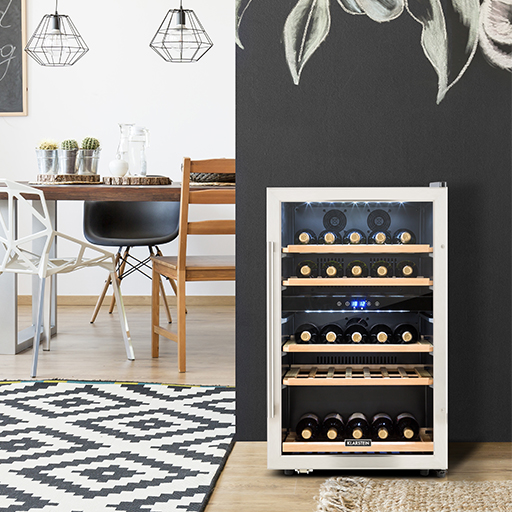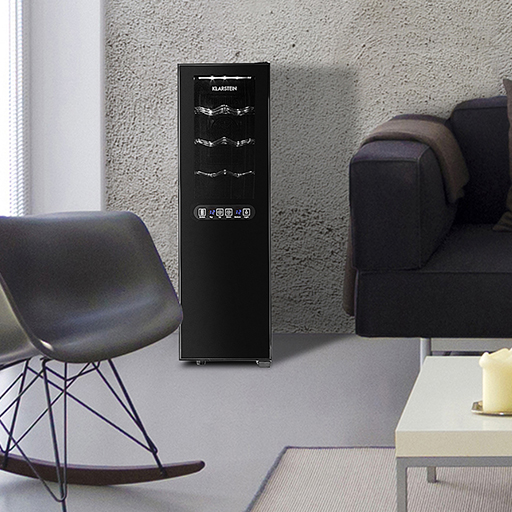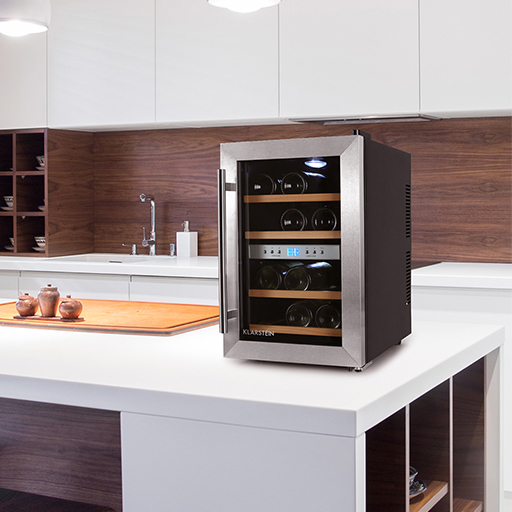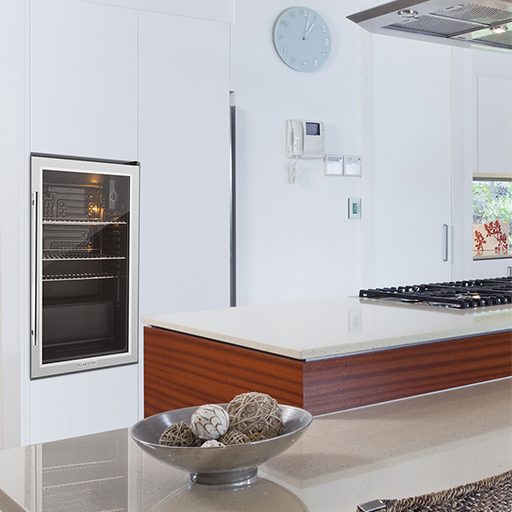Guide to wine coolers
Whether enjoyed as part of a relaxing meal, together with friends, or with a romantic dinner—for many people, wine is an integral part of life. Wine lovers appreciate not only the importance of the quality of the wine itself, but also the role played by proper storage and presentation.
Creating the ideal environment for your wine requires a combination of technical precision and appropriate styling. A dedicated wine cooler allows you to achieve both brilliantly.
Klarstein beverage coolers represent not only an optical highlight for the home or restaurant, they provide peace of mind by offering a wide range of functions to ensure optimal storage and pure enjoyment. Here, we will discuss the most important factors when considering storage alternatives and help you decide whether a wine cooler is the right solution for you.
1. Technological alternatives to a wine cellar
Connoisseurs, in particular, those investing in high-quality wine, want to ensure proper storage. But how should wine be stored to protect its value and, when desired, to allow it to mature? Four points are especially important when considering storage:
- Temperature
- Humidity
- Vibration
- UV exposure
Consistent temperature and appropriate humidity are the two most important factors when storing wine. But it should also be protected from vibration and UV radiation. A classical cellar would provide the perfect—and natural—environment. Unfortunately, few houses or apartments offer a suitable space meeting these requirements. Modern basements are often subject to temperature fluctuations, low humidity or UV radiation from windows.
Reason enough to search for a better alternative. For those lacking a traditional cellar, a beverage cooler can provide excellent longer-term storage. In recent years, wine cooler technology has advanced considerably and can now create ideal conditions for protecting bottles under precisely controlled conditions.
2. Types of wine cooler
Before choosing a solution, it is wise to first survey the options. Simple storage units are climate-controlled cabinets that maintain ideal conditions in one stable climate zone. They typically provide ventilation, high humidity, and vibration dampening. Since only a single stable temperature is maintained, the underlying technology is not as complex as a dual zone wine cooler, and these models are correspondingly less expensive.
When storing different varieties of wine, for example, whites and reds, opt for a wine cooler with at least two different temperature zones. The main advantage of such a cooler is that wines can be enjoyed immediately without first having to be brought to the desired temperature. The drawback of coolers is that they are primarily designed for short or medium-term storage, and not as a long-term repository.
3. Factors affecting the purchasing decision
3.1. Size
When selecting a model, first consider:
- Available space
- Location
- Form (built-in or freestanding)
- Capacity
A built-in beverage cooler is the most cost-effective solution. This keeps your wines close at hand, and space requirements are modest. Unfortunately, storage is also limited, with capacity typically topping out around 20 bottles.
Naturally, a freestanding wine chiller can hold a large number of wine bottles and can be flexibly integrated into the environment, even serving as an optical highlight. Especially in gastronomy or in the homes of passionate oenophiles, storage requirements can grow to the hundreds of bottles. For large collections, freestanding coolers are a good choice.
3.2. Design – interior – layout
After settling on a capacity, the next step is picking a design. Begin with practical considerations like whether the door mount is on the left, right, or is flexible. The exterior can be simple, elegant or robust, and various finishes are available, for example, stainless steel, plastic or wood. Wine coolers for the cellar or a storage room can usually dispense with expensive design elements.
Nevertheless, when appropriate, a wine cooler can also make a visual statement, making not just the wines, but also the home shine.
In general, materials that are easy to clean are preferable. A plain black cabinet with glass door and tasteful interior lighting makes an excellent impression.
Beyond simple capacity, the details of shelving are important:
- Number of levels
- Ease of cleaning
- Horizontal or vertical bottle storage
3.3. Temperature
To get the most out of your wine, buying a good wine is only the first step: wine matures in the bottle and only reaches its full potential at the right temperature. Wine collectors, hoteliers, and private winemakers—all face the same challenge.
Before you buy, first ask yourself whether the wine should be held at the perfect drinking temperature at all times or whether you would like the ability to store it long enough for it to mature.
Optimal drinking temperature varies according to the type of wine. A good white is served refreshingly cool and is especially enjoyable with a light meal in the summer. The drier the white, the higher the proper drinking temperature, as a rule between 11°C–14°C (52°F–57°F). If you want to allow your whites to mature, you should ideally simulate the changing of the seasons: store them at slightly elevated temperatures in summer (about 8°C, or 46°F) and lower temperatures in winter (about 6°C, or 43°F).
The relative humidity must also be kept high to guarantee quality. By contrast, rosés are not suitable for long-term storage. They are sold shortly after bottling and should not be stored for longer than two years. There is nothing to be gained by allowing them to mature for more than one year.
Once a rosé has been opened, it should be consumed the same day. Its storage temperature is similar to that for whites and is ideally even colder, between 7°C–12°C (45°F–54°F). It’s also important to note that the wine should be kept between 5°C–8°C (41°F–46°F) before opening.
Red wines enjoys a different storage temperature, which should be between 15°C–18°C (59°F–64°F). The right drinking temperature can even be as high as 20°C (68°F)—considerably warmer than the other two wines. Only at this temperature can the bouquet unfold completely.
If you have stored the wine colder, you should be careful to slowly bring it to a warmer temperature to avoid damaging it. Accordingly, some wine coolers offer a function for slow warming. If you want to have red wine for dinner, you should store it unopened at room temperature (for just under half an hour).
In general, red wines can remain in storage longer, whereas whites mature after a maximum of a few years. If you have only one goal, either storing red wines long-term or keeping white wines at the optimum drinking temperature in your home, a cooler with one temperature zone is the right choice. If you want to store red wines but also want whites properly chilled at all times, a dual zone wine cooler is ideal.
For the catering industry, more than two zones could be required, for example, for reds, whites, and sparkling wine or champagne. In any case, care should always be taken to maintain a constant temperature, which is only adjusted for the seasons. A temperature that fluctuates daily can negatively affect wine quality.
3.4. Humidity
A wine chiller can also maintain the proper humidity typically found in a wine cellar, which is suitable for long-term storage. If you want to allow your bottles to mature, you should take care to keep the relative humidity between 75% and 85%. This is particularly important for wine bottles with real corks. These can shrink when the humidity is too low, resulting in air entering the bottle, causing spoilage.
Ventilation air, which also plays a role, is often optimized using an activated carbon filter. This eliminates unwanted odors and protects the wine’s taste.
3.5. Vibration
A wine requires not only a constant temperature, but must also be undisturbed. Anyone who buys a wine cooler should consider adjustable feet to prevent the appliance from moving. Any vibration have a negative effect on the maturing process. Also, the cooling unit, in combination with the compressor, should run smoothly to ensure as little vibration as possible.
3.6. Light
When buying a wine cooler, attention must also be paid to the effects of light. The taste of a wine cannot be guaranteed over a longer period of time if it is constantly exposed to light. The Sun’s rays (which contain UV radiation) can be harmful, negatively affecting the wine’s aroma. UV protection is now provided by well-insulated glass doors with UV filters. Equipping wine coolers with interior light is now safe, since LED light does not emit UV radiation. If you really want to store wine bottles for years, you should completely avoid the use of light, even if it is artificial. Otherwise, there is no reason to avoid a design with pleasing lighting.
3.7. Noise
The noise emitted by the coolers is given in decibels. Continuous cooling causes noises which cannot be avoided. If you would like to place the wine cooler in a room that does not allow for much excess noise, such as the living room or the kitchen, you should look for a model with a maximum of 40 dB. If you want to locate the cooler in the basement or in a storage room, the noise need not factor into your decision.
3.8. Energy
Of course, the price of energy also plays an important role when selecting the right model. This applies not only to cost of purchase, but also to operating costs. The two main points are electricity consumption and energy efficiency.
There are 10 energy consumption classes in Europe. The highest efficiency is given to devices with the designation A +++, and the lowest efficiency is ranked as “G”. The lower the efficiency, the lower the rating on the scale. In the Unites States, The Energy Guide and Energy Star programs serve the same purpose.
In addition to the exact rating indicated with an arrow, the label also reveals the energy consumption in kWh per year, the cooler capacity in bottles, and the operating noise. The annual cost can easily be calculated by multiplying the current price of electricity by the indicated kWh shown on the label.
This cost must always be seen in relation to the functions and size of the cooler. The larger it the appliance, the higher the operating cost—even if the model has a good classification. The storage location must also be considered, since a cooler environment like a cellar will have a positive impact on cooling performance. If you spend more money to purchase an efficient model, this saves money in the long run on operating costs.
3.9. Special functions
Families may benefit from a lock to prevent children from accessing alcohol or to protect expensive products. Another interesting feature is the temperature alarm to ensure thermal stability.
4. Conclusion
Wine has character, and if you care about quality, storage is an essential aspect to consider. There are many things to consider choosing a wine cooler, and everyone should answer the following questions before beginning the search for the right model.
4.1. Placement & Size:
Where will the cooler be placed, and how many bottles must it be able to hold? Should it be a built-in or freestanding model?
4.2. Storage period:
Should it also be suitable for long-term storage, or is the priority on consumption in the near future at the optimal drinking temperature?
4.3. Model selection:
Do you require a wine cooler with one temperature zone, or two? This depends on whether you want to store several different types of wine.
Does the model allow proper storage to prevent the influence of UV radiation or vibrations that could harm the wine? Can the temperature and humidity be adjusted properly?
Which additional functions do you require, for example, an anti-vibration system, child safety lock or interior lighting?
Does the design have to blend into the environment?
4.4. Costs:
What is the maximum cost of the wine cooler, and what is the maximum annual operating cost based on energy classification?
Once well informed, you can begin the search for the right wine cooler for you!





